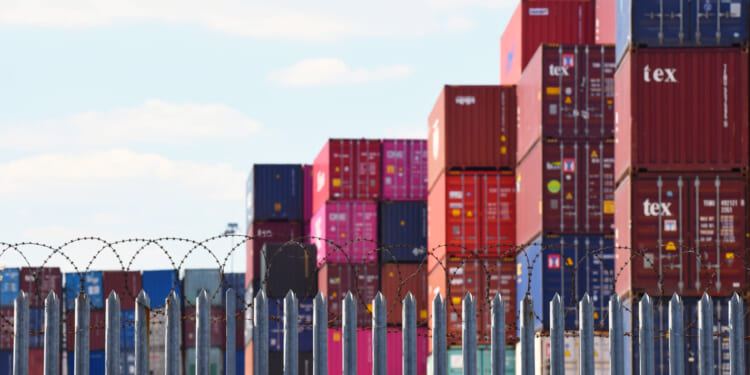President Trump is adhering to economic theory with regard to his tariff policies and trade deficits; with time it will pay off. He understands that America’s perennial trade deficits predispose to our budget deficits, which merely increases America’s greatest nemesis — the national debt.
Washington’s fiscal deficit is not necessarily a discretionary act…. It is the virtually-automatic response from the external (trade) deficit.
The U.S. has run 54 years of trade deficits, and our manufacturing capacity has degraded. America manufactured around 90 percent of the goods Americans consumed under President Reagan. Today, it is closer to 75 percent. And until Donald Trump entered Washington, there was no end in sight.
President Trump’s tariff policies (contrary to the rhetoric of liberal economists) are not designed for protectionism; rather, they are constructed to induce countries with significant trade imbalances with the U.S. to reduce their own “protectionism” and direct capital into real investments in America — buying goods and services and building manufacturing capacity — not merely buying stock in a company.
The trade deal reached with the EU is indicative of Trump’s approach. Announced in July 2025, it involves the EU paying tariffs of 15 percent, while also purchasing $750 billion in U.S. energy products and committing to invest $600 billion in the U.S. by 2028.
Yet, despite continued success with both tariff revenue and trade deficit reductions, some people just won’t admit it.
Recently, a number of economists have offered a defense of America’s trade deficits — past as well as present. Their remarks were made against Trump’s tariff policies which were instituted in an effort to rein in such deficits.
The argument of the economists is that trade imbalances with other countries are of little concern. A trade deficit, they argue, is merely a “counter reflection” of capital flowing into the U.S. — a corresponding surplus. It indicates foreign capital being eager to invest in America. Implied in this view, is the premise that America runs trade deficits because it is an attractive place to put money — a measure of strength, not weakness.
Their contention is simple, but altogether foreign to economic reality. It misconstrues an accounting function with economics — the two are not the same. The fact that trade and capital balances must offset (an accounting function) says nothing about what actually is happening. In other words, this is what the real-world consequences are when the “books balance” but only because domestic income is transferred abroad.
Accounting Is Not Economics
Economics 101 says: someone’s expenditure is someone else’s income or revenue. When a family purchases an item, the expenditure becomes revenue to a manufacturer; the latter then services its payroll resulting in income to a family. So long as spending and production remain in balance, the economy gins along at a level approaching full employment.
When trade is factored into a balanced economy, nothing necessarily changes. The American consumer buys imports, transferring income to foreign consumers with which they buy our exports. Foreigners in return buy our products, giving us income to buy theirs. So long as the flows are balanced, global spending still equals global income — the accounting adds up.
Imbalances change outcomes — even when the accounting functions still “balance.” When Americans buy more from abroad than foreigners buy from us, more spending (capital) leaves the domestic income stream than returns to it. Each dollar of U.S. consumer spending now generates less revenue domestically for U.S. producers. The difference shows up as reduced output (GDP) growth, lower wages, and unless some other factor offsets it, higher unemployment. It isn’t that America is consuming too much; it is that it is earning too little relative to what it spends.
The economists arguing against Trump’s tariffs and promoting trade deficits treat this outcome as a matter of personal preferences of the American consumer. Americans, they imply, prefer to spend today rather than defer purchases to the future and hence, take on debt to fund the difference. But the economists have put the “cart before the horse.” The U.S. does not operate in a trade deficit because the American public wishes to spend beyond their means; rather, our productive capacity is undermined by the persistent surpluses of others — that’s why we run trade deficits. Trump is attempting to address that with his tariffs and stance on trade imbalances.
Countries such as China, Germany, and Japan, historically run trade surpluses vis-à-vis the U.S.; they characteristically pursue policies designed to maximize employment, while maintaining export surpluses.
These nations restrain domestic consumption, keep their currency exchange rates relatively cheap compared to the U.S. dollar, and channel national savings into foreign assets like the U.S. By producing more than they consume, they create a surplus of goods and savings that must find an outlet somewhere else. In a world of relatively “free” open markets, that “somewhere else” is the United States because of its stability and thus safety. We always pay our debts and our economy continues to grow.
The U.S. does not run trade deficits necessarily by choice. But by permitting others to overproduce, we accept the corresponding role of over-consuming, not out of excess appetite but out of economic structural necessity. Our spending provides the liquidity needed for the U.S. “greenback” to function as the world’s reserve currency and provide the demand for goods and services that surplus economies suppress at home.
Trade Deficits, Budget Deficits, and the National Debt
Persistent trade imbalances have consequences: it deprives the United States of income. When foreign nations deliberately under-consume, the demand that would have been sustained by their own workers is instead provided by American consumers. Our spending crosses borders, but the income that would have come back through exports does not. A portion of every dollar Americans spend ceases to circulate in the domestic economy. The income gap must be filled, or the economy contracts — and therein lies the borrowing problem.
Satisfying that income gap occurs through deficit financing — borrowing. When private credit expands — say, during a housing boom — household debt temporarily replaces the missing income from abroad. When private credit collapses, the government steps in. Washington’s fiscal deficit is not necessarily a discretionary act of stimulating the economy. It is the virtually-automatic response from the external (trade) deficit. Politicians who do not want to oversee rising unemployment and falling income will employ deficit spending to keep the economy from contracting. Dollars that leave the country through trade imbalances eventually re-enter the economy but through the auction of Treasury securities and increased federal spending.
One can make the case that the U.S. fiscal budget deficit is a “counter reflection” of its trade deficit. An attempt to close one without addressing the other merely shifts the imbalance around an accountant’s balance sheet and income statement. Cut government spending while imports still exceed exports, and national income falls until tax revenue declines and the deficit reopens. External imbalances make fiscal imbalances and an increase in the national debt inevitable. It is a vicious cycle.
But contrary to the trade-deficit economists — it is not an accounting issue, but real-world economics.
READ MORE from F. Andrew Wolf Jr.:
The Fabric of America… ‘Liberty and Justice for All’


![Scott Bessent Explains The Big Picture Everyone is Missing During the Shutdown [WATCH]](https://www.right2024.com/wp-content/uploads/2025/11/Scott-Bessent-Explains-The-Big-Picture-Everyone-is-Missing-During-350x250.jpg)







![Trump and X Users Brutally Mock ‘No Kings’ Protests with Hilarious Memes and AI Video [WATCH]](https://www.right2024.com/wp-content/uploads/2025/10/Trump-and-X-Users-Brutally-Mock-‘No-Kings-Protests-with-350x250.jpg)






